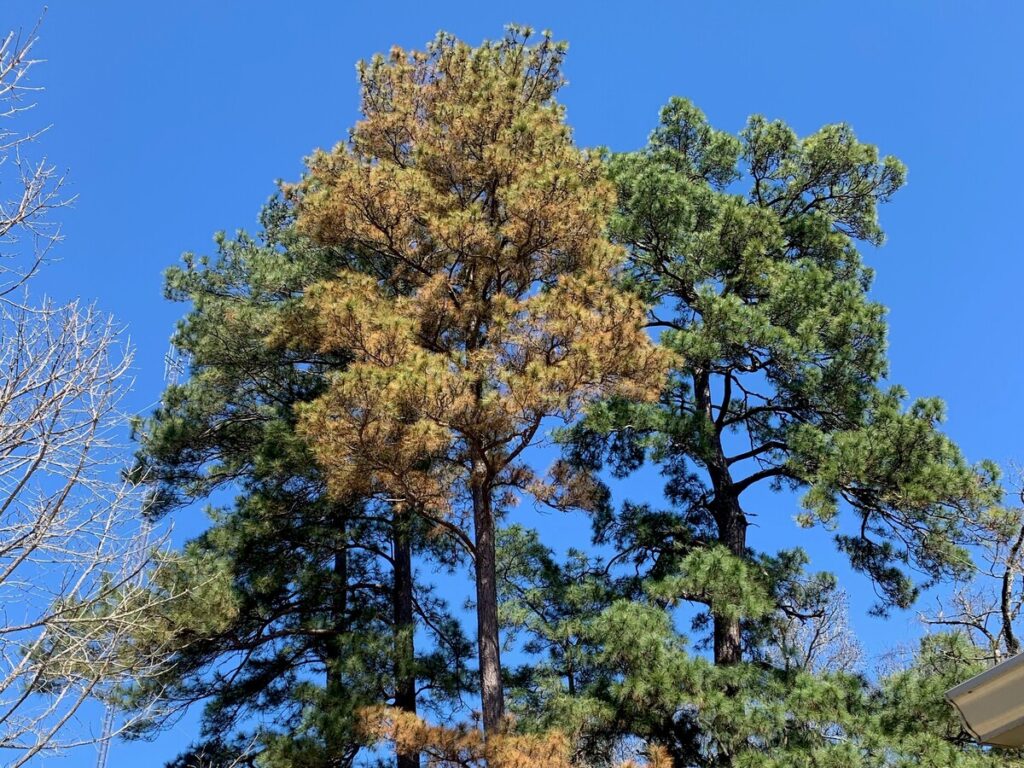When there is an ice storm or sudden freeze, your property’s trees might be adversely affected.
The most common form of damage is branch loss. The sudden additional weight of snow or ice can be enough to cause weaker limbs or sometimes the entire tops of trees to snap off and fall.
If a freeze occurs early in the fall or late in the spring, it can cause the fluids moving within the vessels of the tree’s leaves and limbs to freeze, expand, and even burst. Resulting in wilted leaves, dead limbs, and potentially even cracks in the bark.
Trees that are significantly damaged by winter storms will have weakened immune systems as they use their resources to try and repair the associated damage. This added stress can leave a tree open to attack by secondary pests and diseases.
Additionally, the open wounds left behind from snapped branches can provide an easy opening that many pest species will take advantage of.
Secondary pests to ice damaged pines could include pine beetles and more.
Pine beetles
Pine bark beetles, also referred to as engraver beetles or IPS, as well as black turpentine beetles are both very common species in Texas. Under normal circumstances, they pose little threat to your pines. However, trees that are weakened by ice storm damage are more at-risk to being attacked by engraver beetles.
Pine trees with large breaks on the trunk below their branches or a severe bend from excessive weight are probably in severe distress, as are those with four or less large branches remaining are also particularly vulnerable.
Southern pine beetles (SPB) are another species of beetle infamous for their impact on tree farms and natural forests alike. Much like pine bark beetles and turpentine beetles, they generally attack weakened or distressed pines at low population levels but can quickly spread to and kill perfectly healthy trees as an infestation develops. Thankfully, there have been no reported SPB cases in Texas since 1998, and we take special care to monitor for their return.
Generally, the risk of pine beetles reaching epidemic proportions after a winter storm or freeze is very low. Insect activity is significantly reduced in temperatures below 50° Fahrenheit. Once conditions improve, pine beetles will likely begin to attack some of your dead or dying trees, but much of the timber will spoil and become undesirable before it can be infested, and neither engraver nor turpentine beetles will have any interest in the remaining, healthy pines.
It is still recommended that host trees, those highly infested, be salvaged (removed) from a stand/property, when possible, to reduce the risk of the beetles spreading to other adjacent trees.
Other pests
There are many other pests that can attack not only your pines, but hardwoods too. These can include fungi like root rot, oak wilt, or hypoxylon canker, which are more likely to attack trees with open wounds and cause serious damage to or even kill particularly stressed trees.
These pathogens are present in Texas forests and neighborhoods regardless of the current conditions. But they require extenuating circumstances before they’re able to kill a tree.
A tree infested by fungi will likely develop structural weaknesses as its roots and/or heartwood are eaten away, which can pose a hazard especially if the tree is in proximity to structures. It’s unlikely though that a tree will immediately die in the event of an infestation by almost any single species of pest. It may even take years.
Use our Tree MD tool to determine what pests might be impacting your trees. But before you make any permanent management decisions, contact your local forester.
Treatment
Trees that have experienced limb loss still have a high chance of recovery. The primary consideration is the extent of limb loss. If a damaged tree loses half or more of its canopy over the course of a winter storm, it is significantly less likely to recover, and you should consider having the tree removed.
A common benchmark for pines is if only three or four large limbs remain, the tree will most likely die. Significant breakage on the trunk of a tree will also likely result in its mortality.
Both hardwoods and pines that have experienced only minor limb loss or some cracking on its branches or trunk will likely recover without human intervention. Under normal circumstances, trees possess a large amount of stored energy that they can use in the growing season to sprout new branches and leaves. Even in the case of a tree that suffered serious damage, giving it a few years may be worthwhile because it may still survive.
The only economical treatment for a tree whose structural integrity is compromised, either through storm damage or fungal decay, is outright removal. Structurally unsafe trees can pose serious risks to you and your home and can be a liability concern.
Treating broken limbs is also rarely necessary, as trees are generally capable of repairing themselves, given enough time and stored energy. If you’re concerned about a tree on your property, contact your local forester, or a certified arborist. You can also use My Land Management Connector to identify vendors within your area that may be able to assist you with consulting or performing practical management.
For trees that have special emotional or spiritual significance, there are more strenuous management options like fungicides or pesticides that might be applied to treat for certain diseases or infestations, and ways to improve a tree’s ability to heal over wounds left behind by snapped limbs. However, these treatments are often expensive and may not succeed in saving your tree.
If you lose an important tree on your property from storm damage, or your home is damaged from falling woody debris, you should consider consulting your home insurance provider. You may be entitled to compensation in some form.
